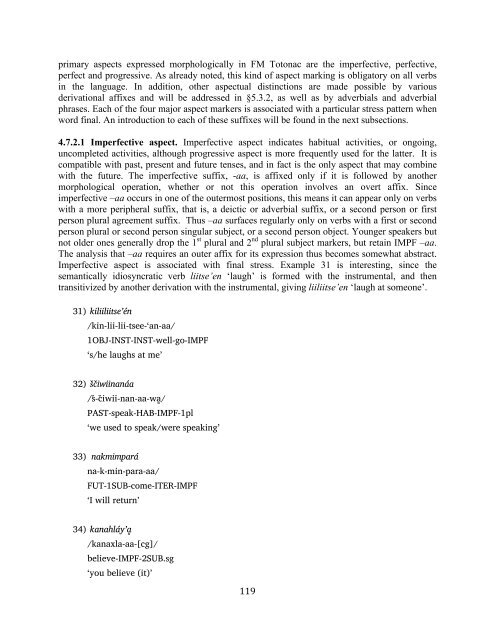The phonology and morphology of Filomeno Mata Totonac
The phonology and morphology of Filomeno Mata Totonac
The phonology and morphology of Filomeno Mata Totonac
Create successful ePaper yourself
Turn your PDF publications into a flip-book with our unique Google optimized e-Paper software.
primary aspects expressed morphologically in FM <strong>Totonac</strong> are the imperfective, perfective,<br />
perfect <strong>and</strong> progressive. As already noted, this kind <strong>of</strong> aspect marking is obligatory on all verbs<br />
in the language. In addition, other aspectual distinctions are made possible by various<br />
derivational affixes <strong>and</strong> will be addressed in §5.3.2, as well as by adverbials <strong>and</strong> adverbial<br />
phrases. Each <strong>of</strong> the four major aspect markers is associated with a particular stress pattern when<br />
word final. An introduction to each <strong>of</strong> these suffixes will be found in the next subsections.<br />
4.7.2.1 Imperfective aspect. Imperfective aspect indicates habitual activities, or ongoing,<br />
uncompleted activities, although progressive aspect is more frequently used for the latter. It is<br />
compatible with past, present <strong>and</strong> future tenses, <strong>and</strong> in fact is the only aspect that may combine<br />
with the future. <strong>The</strong> imperfective suffix, -aa, is affixed only if it is followed by another<br />
morphological operation, whether or not this operation involves an overt affix. Since<br />
imperfective –aa occurs in one <strong>of</strong> the outermost positions, this means it can appear only on verbs<br />
with a more peripheral suffix, that is, a deictic or adverbial suffix, or a second person or first<br />
person plural agreement suffix. Thus –aa surfaces regularly only on verbs with a first or second<br />
person plural or second person singular subject, or a second person object. Younger speakers but<br />
not older ones generally drop the 1 st plural <strong>and</strong> 2 nd plural subject markers, but retain IMPF –aa.<br />
<strong>The</strong> analysis that –aa requires an outer affix for its expression thus becomes somewhat abstract.<br />
Imperfective aspect is associated with final stress. Example 31 is interesting, since the<br />
semantically idiosyncratic verb liitse’en ‘laugh’ is formed with the instrumental, <strong>and</strong> then<br />
transitivized by another derivation with the instrumental, giving liiliitse’en ‘laugh at someone’.<br />
31) kiliiliitse’én<br />
/kin-lii-lii-tsee-‘an-aa/<br />
1OBJ-INST-INST-well-go-IMPF<br />
‘s/he laughs at me’<br />
32) s%c%iwiinanáa<br />
/s"-c"iwii-nan-aa-wa&/<br />
PAST-speak-HAB-IMPF-1pl<br />
‘we used to speak/were speaking’<br />
33) nakmimpará<br />
na-k-min-para-aa/<br />
FUT-1SUB-come-ITER-IMPF<br />
‘I will return’<br />
34) kanahláy’a&<br />
/kanaxla-aa-[cg]/<br />
believe-IMPF-2SUB.sg<br />
‘you believe (it)’<br />
! ""-!

















